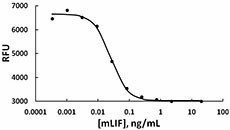- Regulatory Status
- RUO
- Other Names
- MLPLI (melanoma-derived LPL inhibitor), DIA (differentiation-inducing factor), LIF (leukemia inhibitory factor)

-

Mouse leukemia inhibitory factor (LIF) inhibits proliferation of M-1 cells in a dose dependent manner. The ED50 of BioLegend's mouse LIF is 0.05 - 0.2 ng/mL.
| Cat # | Size | Price | Quantity Check Availability | ||
|---|---|---|---|---|---|
| 554002 | 10 µg | $141.00 | |||
| 554004 | 25 µg | $223.00 | |||
| 554006 | 100 µg | $768.00 | |||
| 554008 | 500 µg | $1870.00 | |||
Leukemia inhibitory factor (LIF) is a 20 kD protein that belongs to the IL-6 receptor family. It binds to a heterodimeric receptor composed of a type I transmembrane ligand-binding subunit, the LIF-specific subunit gp190 (LIFR), and the type I transmembrane signal transducing subunit gp130, shared with the other members of the IL-6 family. It especially signals through STAT3 and JAK kinases. LIF expression has been observed in various tissues including thymus, lung, and neuronal tissues. LIF displays diverse biological effects, but is best known for its ability to inhibit the differentiation of embryonic stem cells in mice and contribute to stem cell self-renewal. LIF can be upregulated by proinflammatory cytokines such as TNF-α and IL-17, and elevated levels of LIF have been found in cases of rheumatoid arthritis, neural injury, systemic inflammation, and tuberculosis. Human and mouse LIF share 79% sequence homology and exhibit cross-species activity. However, LIF inhibition of stem cell differentiation appears to be mouse-specific. It is involved in the induction of hematopoietic differentiation in normal and myeloid leukemia cells, induction of neuronal cell differentiation, regulator of mesenchymal to epithelial conversion during kidney development, and may also have a role in immune tolerance at the maternal-fetal interface. Alternatively spliced transcript variants encoding multiple isoforms have been observed for this gene.
Product Details
- Source
- Mouse LIF, amino acids (Ser24-Phe203) (Accession# NP_032527.1), was expressed in E. coli.
- Molecular Mass
- This 180 amino acid protein has a predicted molecular mass of approximately 20 kD. The protein migrates at approximately 20 kD in DTT-reducing conditions and approximately 18 kD in non-reducing condition by SDS-PAGE. The predicted N-terminal amino acid is Ser.
- Purity
- >98%, as determined by Coomassie stained SDS-PAGE.
- Formulation
- 0.22 µm filtered protein solution is in PBS, pH 7.4.
- Endotoxin Level
- Less than 0.1 EU per µg of protein as determined by the LAL method.
- Concentration
- 10 and 25 µg sizes are bottled at 200 µg/mL. 100 µg size and larger sizes are lot-specific and bottled at the concentration indicated on the vial. To obtain lot-specific concentration and expiration, please enter the lot number in our Certificate of Analysis online tool.
- Storage & Handling
- Unopened vial can be stored between 2°C and 8°C for up to 2 weeks, at -20°C for up to six months, or at -70°C or colder until the expiration date. For maximum results, quick spin vial prior to opening. The protein can be aliquoted and stored at -20°C or colder. Stock solutions can also be prepared at 50 - 100 µg/mL in appropriate sterile buffer, carrier protein such as 0.2 - 1% BSA or HSA can be added when preparing the stock solution. Aliquots can be stored between 2°C and 8°C for up to one week and stored at -20°C or colder for up to 3 months. Avoid repeated freeze/thaw cycles.
- Activity
- Mouse LIF inhibits proliferation of M-1 cells. ED50 = 0.05 - 0.2 ng/mL.
- Application
-
Bioassay
- Application Notes
-
BioLegend carrier-free recombinant proteins provided in liquid format are shipped on blue-ice. Our comparison testing data indicates that when handled and stored as recommended, the liquid format has equal or better stability and shelf-life compared to commercially available lyophilized proteins after reconstitution. Our liquid proteins are verified in-house to maintain activity after shipping on blue ice and are backed by our 100% satisfaction guarantee. If you have any concerns, contact us at tech@biolegend.com.
- Product Citations
-
Antigen Details
- Structure
- Monomer
- Distribution
-
Expressed in the trophectoderm of the developing embryo, activated CD4+ T cells.
- Function
- Inhibits embryonic stem cell differentiation, induces the terminal differentiation of myeloid leukemic cells.
- Interaction
- Embryonic stem cells.
- Ligand/Receptor
- LIFR
- Bioactivity
- mLIF inhibits proliferation of M1 cells.
- Cell Type
- Embryonic Stem Cells, Hematopoietic stem and progenitors
- Biology Area
- Cell Biology, Immunology, Stem Cells
- Molecular Family
- Cytokines/Chemokines, Growth Factors
- Antigen References
-
1. Moreau JF, et al. 1988. Nature 336:690.
2. Tomida M, et al. 1993. FEBS Lett. 334:193.
3. Metcalfe SM. 2011. Genes Immun. 12:157.
4. Voyle RB, et al. 1999. Exp. Cell Res. 249:199.
5. Slaets H, et al. 2010. Trends Mol. Med. 16:493. - Gene ID
- 16878 View all products for this Gene ID
- UniProt
- View information about LIF on UniProt.org
